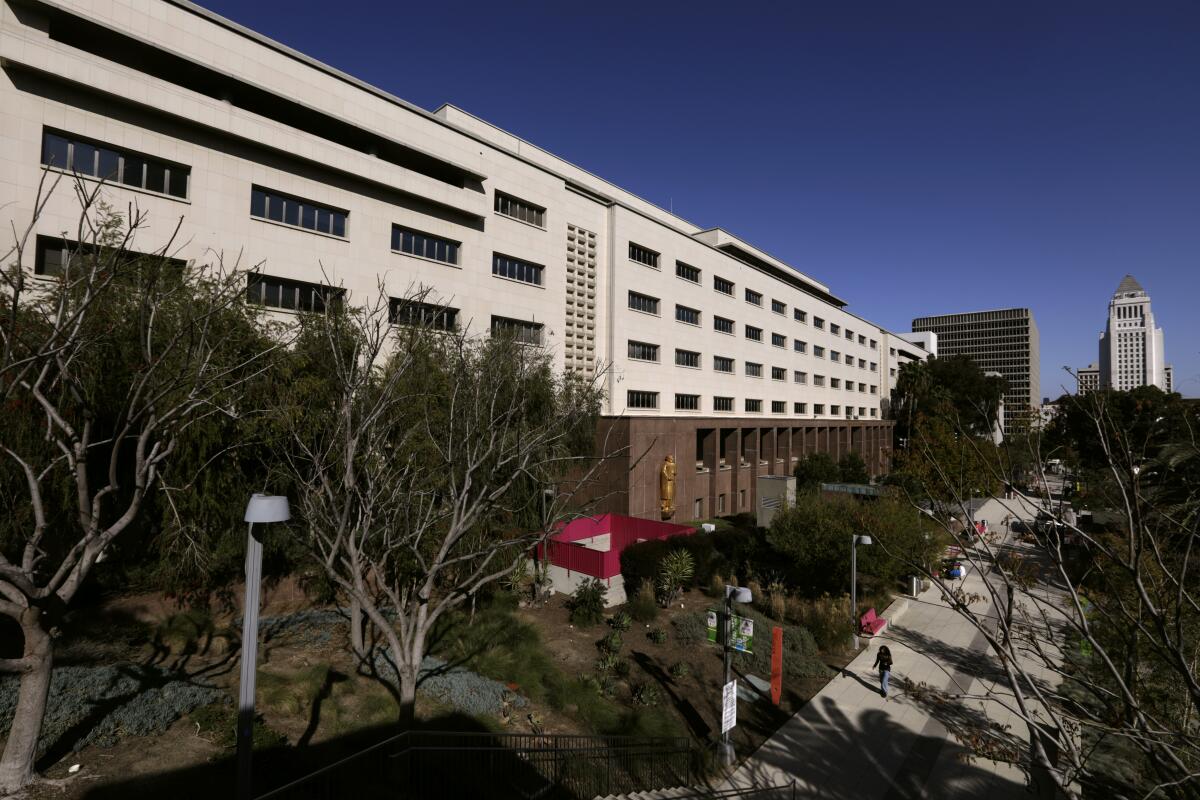L.A. County warns of possible $3-billion hit to budget from sex abuse claims

- Share via
Los Angeles County officials revealed their $43-billion recommended budget for the upcoming fiscal year this week — a spending blueprint they promised would keep the region’s social safety net intact even as the county prepares to pay a steep price for how poorly officials have historically handled the jails and juvenile halls.
At a Tuesday Board of Supervisors meeting, Chief Executive Officer Fesia Davenport warned that the county may have to spend as much as $3 billion resolving claims of sexual abuse at its facilities.
“Beyond the traumatic personal impact on the survivors of abuse, these cases could have a profound impact on the county budget for decades to come,” Davenport said.
In a letter accompanying the budget, she said the claims presented one of the “most serious fiscal challenges in recent history.”
At $43 billion, the county has one of the largest budgets in local government, bigger than many states and triple that of the city of Los Angeles. It’s just a little more than what experts estimate it will cost to repair all the bridges in the U.S. It’s just a little less than what the U.S. gave to Ukraine in military aid in the first year or so of the war. It’s about what Elon Musk offered for Twitter.
The Board of Supervisors weighed in Tuesday on the spending plan. The budget, if approved by the board in its current form this summer, would funnel hundreds of millions toward services that aim to get people off the streets and out of jail.
The plan puts $692 million toward homeless services, most of it coming from money generated through Measure H, a voter-approved sales tax to fund homeless programs. And $288 million would go toward “alternatives to incarceration.”
“I believe this budget sets the county on the right foot for the next fiscal year to keep ourselves accountable to our public for the job we were all elected to do and again strengthens that safety net that we know the county is responsible for,” said Board Chair Janice Hahn.
Davenport told the board the budget was put together in the face of a “mixed” economic forecast and warned the county may have to tighten purse strings down the road — in part to cover the recent deluge of claims of sexual abuse at county facilities.
To resolve an estimated 3,000 sexual abuse claims, the county’s lawyers predict it could be forced to spend anywhere between $1.6 billion and $3 billion. That’s more than the county plans to spend next year on its probation, fire, and parks and recreation departments — combined.
Matt McGloin, a top budget official with the county’s Chief Executive Office, told reporters the lawsuits would have an effect “unprecedented in scope.”
The flood of claims stem from a state law that granted victims of childhood sexual assault additional time to file lawsuits. Like many California institutions with checkered histories, the county has been flooded with lawsuits, many from plaintiffs who were once at the now-infamous MacLaren Children’s Center, where physical and sexual abuse ran rampant.
Davenport told reporters the county was still figuring out where the money to pay victims would come from.
“Everything has to be on the table,” said Davenport, adding they’d consider cutting department budgets or dipping into the county’s rainy day fund.
The financial repercussions from past crises arrive as the county faces a new wave of problems in its jails and juvenile halls. Ten people have died in county jails this year — a death toll advocates attribute in part to overcrowding in decrepit facilities. Meanwhile, conditions in the juvenile halls have become so deplorable that state regulators are mulling shutting them down.
More than 50 members of the probation workers’ union showed up at the board meeting Tuesday morning. Dwight Thompson, a vice president with the Deputy Probation Officers’ Union, said members were there to implore the board to fix working conditions within the facilities and bargain “in good faith” in contract negotiations.
The supervisors then went into closed session, which spokespeople said was to discuss the probation department. The decision left a strange vacuum inside the chamber for the better part of two hours; one man stayed in the board room yelling profanities and singing while probation department members milled outside.
According to budget documents, the county is anticipating an “overhaul” of the county’s probation system, which could require funding for “additional investments in staff, programs, and facilities.”
Such investments are not detailed in the recommended budget for probation, and funding for the department is roughly unchanged from the year before. According to budget officials within the CEO’s office, the total recommended probation budget is $1.059 billion — a $956,000 decrease from the year before.
The recommended budget for the sheriff’s department rose to $3.99 billion, an increase of about $136 million, according to the budget officials. The budget dedicates $6.6 million to fund the new Office of Constitutional Policing, which Sheriff Robert Luna created to fix conditions in the jails and eradicate deputy “gangs.” County leaders said an additional roughly $50 million would go to improve “unacceptable conditions” in the jails.
The funding drew a strong rebuke from progressive advocates, who argued the county was not following through on its promise to reorient the county’s programs away from jail.
“It’s not actually reflective of what the community has been calling for,” said Megan Castillo, the policy and advocacy manager at La Defensa, a group pushing for prison alternatives. “It’s a status quo budget. It’s a budget that we’ve seen time and time again where law enforcement receives increases in funding.”
County officials maintained they were following through on their promises to move away from incarceration, pointing to $288 million going to programs and projects that aim to keep people away from jail, such as job training, housing, and reentry and mental health services.
That portion of the spending plan was borne out of Measure J, a since-overturned ballot measure aimed at criminal justice reform that county voters approved in 2020 in the aftermath of the killing of George Floyd by police officers in Minneapolis.
The measure required the county to set aside 10% of its “locally generated unrestricted revenues” — money the county controls directly, such as property and sales tax, that isn’t already earmarked for another purpose — on programs that kept people out of jail.
Though a judge ultimately ruled the measure unconstitutional, county leaders promised to follow in the spirit of what voters demanded and funnel one-tenth of these flexible dollars toward jail alternatives.
Bamby Salcedo, head of the TransLatin@ Coalition who helped pass the measure, said she had originally expected closer to a billion dollars funneled to these programs by this fiscal year. With $288 million dedicated this year, she said she felt the board was “shortchanging” the community.
Davenport told the board she believes the county has fulfilled its pledge.
“While some advocates remain dissatisfied, moving from zero to more than half a billion dollars in funding in the space of three years is unprecedented for just about any county initiative,” she said.
More to Read
Sign up for Essential California
The most important California stories and recommendations in your inbox every morning.
You may occasionally receive promotional content from the Los Angeles Times.











